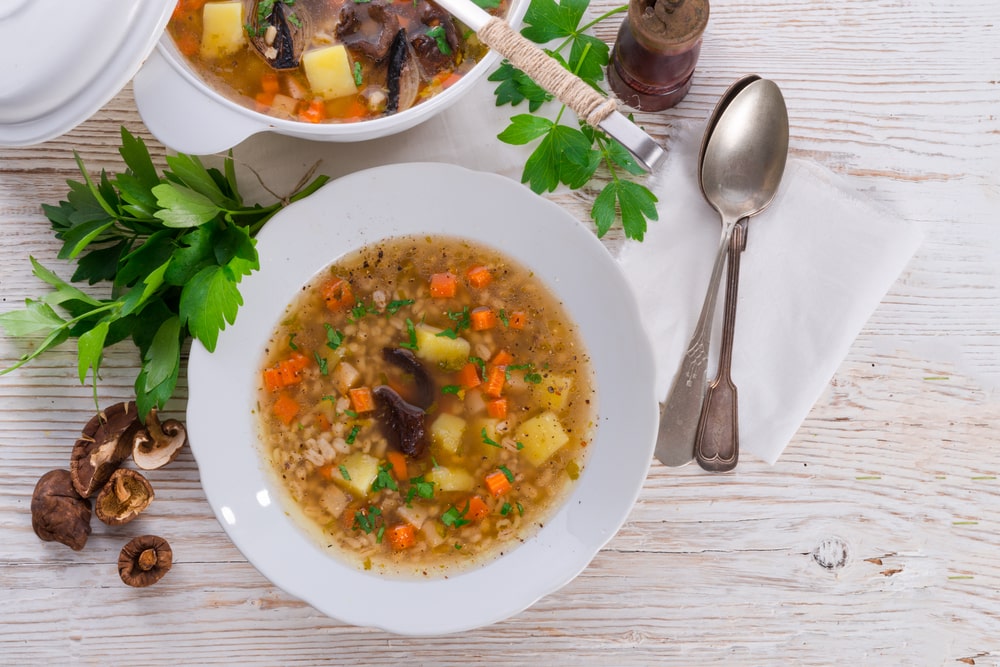
For everyone who is trying to give up on junk food and start munching on healthy food, barley becomes one of the most important parts of their recipes since it can be made into different recipes. Similarly, barley can be added to soups for thickening and for adding an extra punch of nutrients to the already-healthy soup. However, when it comes down to making soup, there are two types of barley, such as pot barley vs. pearl barley for soup, and we are here to explain how these two varieties are different!
Pot Barley vs Pearl Barley For Soup
Pot Barley
To begin with, pot barley is defined as the regular and simple barley with the husk removed. The husk is the outermost layer of the barley, and it’s not the edible option. The removal of husk results in the nutty flavor of the barley. For using pot barley for soup, you need to soak it in cold water for a night and be brought to the boiling phase. As far as the duration for soup is concerned, it will need around fifty minutes but will enhance the texture and thicken the consistency.
On top of everything, pot barley is pearled for a shorter span of time, which means that its bran will be intact. The best thing about pot barley is that it’s the most nutritious variety of barley, but it can be challenging to find because the demand is less, and not many supermarkets have it in stock. The pot barley only has the outer husk removed, and the bran remains intact. It has a high fiber content as well as beta-glucan, which helps with blood sugar and cholesterol levels.
The best thing about pot barley is that it helps with weight loss and will improve digestion. Even when added to the soup, it will improve the creamy texture. In addition, it can be added to soups for thickening them and enhancing the overall consistency. However, you need to remember that adding pot barley to the soup will result in a nuttier flavor as well. On top of everything, pot barley cannot be used in desserts as compared to pearl barley which can be used in porridges.
If you have to cook broth for the soup, you can add pot barley at that time to make sure it’s cooked perfectly and will also lead to better flavor. However, don’t forget to rinse the barley for washing away the excess starch.
Pearl Barley
Pearl barley is another variety of barley that’s been put through the pearling machine, which helps remove the inedible outer layer (yes, we are talking about husk). The pearl barley is a more refined form of barley because it is husked as well as polished. However, it also results in a low nutritional value. When it comes down to using pearl barley for soup, it doesn’t need soaking and will achieve a tender texture within thirty minutes or even less.
Keep in mind that husking and the entire polishing process will remove the bran layer. While it’s a great addition to soup, it can also be used to make sweet barley pudding (it will turn out fine). In fact, there are different forms of pearl barley out there, including heavily pearled barley and lightly pearled barley. The lightly pearled barley has a tan color, while the heavily pearled barley has a white bottom. Also, it is pretty easy to find pearl barley in a nearby supermarket.
It is a common notion that pearl barley is not very healthy, given the heavy refining and polishing, but it still has a slight amount of bran left. In addition, the entire kernel is loaded with fiber. You might not know this, but pearl barley is one of the most commonly consumed barley varieties, particularly because it cooks pretty quickly and has a less chewy texture as compared to other barley varieties. In fact, the barley flour is made from pearl barley.
Pearl barley is pretty similar to wheat because both of them have similar minerals, protein, caloric, and vitamin content. However, some brands might have higher lysine content. In addition to soups and pudding, it’s also a great addition to potages and stews. For the most part, it has a cereal-like neutral flavor. When added to soups, it will enhance the creaminess. Overall, it’s a pretty versatile option and will become an ultimate kitchen staple.